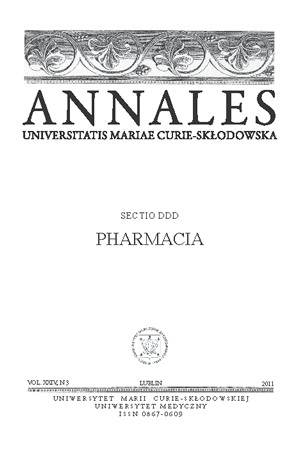Sprouts of selected plants as a source of bioavailable antioxidants and lipoxygenase inhibitors
DOI:
https://doi.org/10.12923/Keywords:
phenolic compounds, sprouts, bioaccessibility, bioavailability, lipoxygenase inhibitionAbstract
The beneficial effect of phenolics comes in part due to their antioxidant activity. Sprouts provide higher nutritive value than raw seeds. Thus, the aim of this study was to evaluate bioaccessibility and bioavailability of biologically active compounds from commonly consumed sprouts. Lentil sprouts were the best source of bioavailable phenolics and flavonoids (about 100%). Bioavailability of phenolics from other sprouts did not exceed 50%, whereas flavonoids bioavailability ranged from 16.85% to 36.15%. Bioavailability of free radical scavengers ranged from 56.29% in radish to 73.66% in alfalfa sprouts. Metal ion chelators were potentially the most bioavailable antioxidants (about 90% in all cases). All tested sprouts contained bioavailable reductive compounds, whereas the best source of them were Brasicaceae sprouts (BAV= 186.21% for radish and 230.21% for cress). Studied seedlings, except alfalfa, contained bioavailable lipoxygenase inhibitors, bioavailability ranged from 60.8% to 72.03%. Results confirmed the fact that plant seedlings contained compounds with multi-directorial health-promoting activities.
References
1. Axelroad B, Cheesborough TM, Laakso S: Lipoxygenases in soybeans. Methods Enzymol. 71, 441, 1981.
2. Bahorun T, Luximon-Ramma A, Crozier A, Aruoma OI: Total phenol, flavonoid, proanthocyanidin and vitamin C levels and antioxidant activities of Mauritian vegetables. Journal Sci. Food Agric. 84, 1553, 2004.
3. Cevallos-Casals BA, Cisneros-Zevallos L: Impact of germination on phenolic content and antioxidant activity of 13 edible seed species. Food Chem. 119, 1485, 2010.
4. D’Archivio M, Filesi C, Di Benedetto R, Gargiulo R, Giovannini C, Masella R: Polyphenols, dietary sources and bioavailability. Ann. Ist. Super. Sanita. 43, 348, 2007.
5. Elles M, Blaylock MJ, Huang JW, Gussman CD: Plants as a natural source of concentrated mineral nutritional supplements. Food Chem. 71, 181, 2000.
6. Gil-Izquierdo Mi, Gil F, Ferreres Fa, Tomás-Barberán Fa: In vitro availability of flavonoids and otherphenolics in orange juice. J. Agric. Food Chem. 49, 1035, 2001.
7. Guo JT, Lee HL, Chiang SH, Lin HI, Chang CY: Antioxidant properties of the extracts from different parts of broccoli in Taiwan. J. Food Drug Anal. 9, 96, 2001.
8. Oyaizu M: Studies on products of browning reaction – Antioxidative activities of products of browning reaction prepared from glucosamine. Japan J. Nutr. 44, 307, 1986.
9. Pinelo M, Arnous A, Meter AS: Upgrading of grape skins: Significance of plant cell-wall structural components and extraction techniques for phenols release. Trends Food Sci. Technol. 17, 579, 2006.
10. Re R, Pellegrini N, Proteggente A, Pannala A, Yang M, Rice- Evans C: Antioxidant activity applying an improved ABTS radical cation decolorization assay. Free Rad. Biol. Med. 26, 1231, 1999.
11. Singleton VL, Rossi JA: 1965. Colorimetry of total phenolics witch phosphomolybdic-phosphotungstics acid reagents. Am. J. Enol. Vitic., 16, 144, 1965.
12. Szaufer-Hajdrych M: Phenolic acids in leaves of species of the Aquilegia genus. Herba Pol, 50, 10, 2004.
13. Tagliazucchi D, Verzelloni E, Bretolini D, Conte A: In vitro bio-accessibility and antioxidant activity of grape polyphenols. Food Chem. 120, 599, 2010.
14. Tarko T, Duda-Chodak A, Sroka P, Satora P, Michalik J: 2009. Transformations of phenolic compounds in an in vitro model simulating the human alimentary tract. Food Technol. Biotechnol. 42, 456, 2009.
Downloads
Published
Issue
Section
License
Copyright (c) 2011 Authors

This work is licensed under a Creative Commons Attribution-NonCommercial-NoDerivatives 3.0 Unported License.


